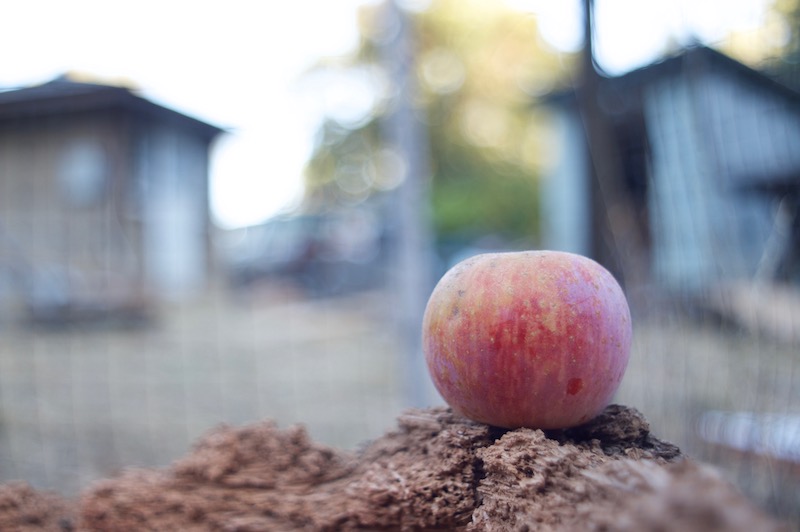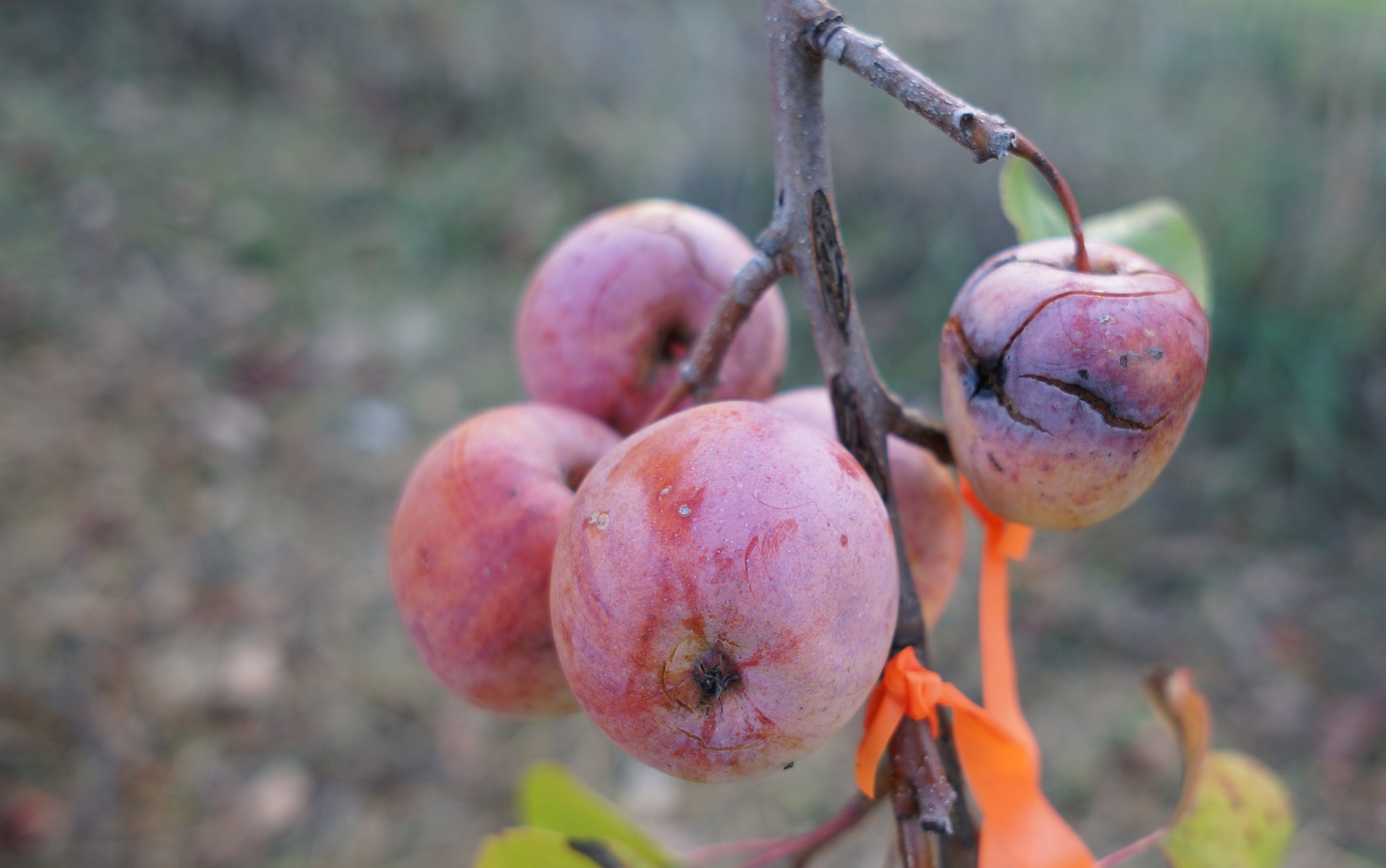When I moved here 12 years ago, one of the first things I did was start to plan my fruit orchards. I well knew then that the time to plant a fruit tree is ten years ago, now I might extend that to 15. I began doing research on apple varieties, which I was very unfamiliar with. I figured there must be hundreds of them, but the best resource I had available was a thick book called Cornucopia, a source book of edible plants which only listed a few of what I later found out were probably tens of thousands of named varieties. I also talked to friend and fruit explorer Freddy Menge, who made his best recommendations at the time. I had helped Mark Dupont of Sandy Bar nursery graft his first batch of fruit trees many years before, and had an outstanding favor owed for fruit trees whenever I finally got my own place. I called in that favor. Looking through their catalogue, they said they had a variety called cherry cox that had become a homestead favorite. I was intrigued. They had no trees to sell that year, but Mark sent me a scion, one of the first scions I grafted onto frankentree. I've since sent out lots of scions to other people all over the country.
Cherry Cox has not disappointed. It really does taste like cherries, among other flavors. Few descriptions mention that it has a cherry flavor, suggesting even that the name is for the redder color it has. There is no doubt though that the name is from the flavor, though I don't doubt that it does not always develop and some say they can't detect it at all. It was also precocious, being one of the first apples to ever fruit on frankentree and one of the most consistent since. If anything, it sets too much fruit, though it has taken years off as almost any apple will do when poorly managed. It seems healthy enough so far, but I can't say too much about that as apple diseases are just getting a real foothold here. It does get scab, and I think it could be called moderately susceptible. Don't quote me on that, it's just a vague impression.
Cherry Cox is a sport of the very famous Cox's Orange Pippin. A sport is a bud mutation. One bud on a tree mutates into something new and thus begins a new variety, no tree sex required. While many sports are very minor variations on the parent tree, Cherry Cox seems to be considerably different than it's parent. It tastes different, performs different, allegedly keeps longer, and I'd just about bet that if you planted rows of each side by side there would be some obvious differences. I was at my friend Tim Bray's orchard and his Cox's Orange Pippins were notably small and the trunks and branches completely covered in lichens, unlike the other trees. They are known for their poor growability and have no doubt only survived by the virtue of exceptional flavor. Cox's Orange Pippin is widely used in apple breeding because of it's eating quality, and is probably the apple most commonly said to be the best out of hand eating apple in the world. Cox's Orange Pippin is indeed one of the few apples I've ever eaten worthy of the classification "best". Even at it's best, Cherry cox is still not in that category. It's a good lesson though that Cox's Orange Pippin seems to do poorly under my conditions and cherry cox is consistently good to very good.
Flavor wise, Cherry Cox has a lot going on, like it's parent Cox's Orange Pippin it is complex. Obvious flavors are cherry, something almost like cherry cough drops, but in a good way, Anise is also present and I've detected some flavor of spice. There is certainly more going on, other fruit flavors, but I'm not good at picking them out. If I were to change things about Cherry Cox, I would. It could use more sugar, which would bring the flavors out more. Have you ever noticed how much better fruit tastes when you sprinkle sugar on it? It's not just that it's sweeter, sugar is to fruit what salt is to meat and savory foods. Cook a fantastic soup with no salt and you will barely taste the potential of it's flavor. Add salt to it and boom, flavor city. The cherry flavor develops early in cherry cox, but the sugar develops late. It is a fairly acidic apple, and maybe even tart before it gets really ripe. I would not reduce the acidity, I would just balance it with more sugar. More sugar would also make it a richer flavored apple. It can be a little thin tasting at times. More scab resistance wouldn't hurt. In the Beauty department it lacks nothing. It's is a beautiful apple. it can grow plenty large under good cultural conditions, though it is not generally a very large apple. Cherry Cox is a little known and little grown apple. I doubt it has great potential as a broader market apple, but it has huge potential as a small scale specialty orchard and farmer's market apple. And then there is the breeding potential.
Looking toward improvement, I think cherry cox is very promising breeding material. If nothing else for the cherry flavor, but it also must carry most of the exceptional flavor gene pool of Cox's Orange Pippin. My own breeding efforts include Cherry Cox crossed with various other apples. If my efforts don't breed anything exceptional, maybe they will produce something that is worth using in further breeding. I've crossed it with several red fleshed apples in the hopes that I might be lucky enough to co-mingle the berry flavors of blood apples with C.C.'s complexity and cherry flavor. I've also crossed it with Sweet Sixteen, which has sometimes a cherry candy component, while also being a good grower and carrying some disease resistance. I've crossed it with Wickson for higher sugar content and unique flavor and probably others I'm forgetting about. I think Golden Russet might be a good candidate since it is one of the best apples I've ever tasted, and it also has an extremely high sugar content. I'd like to see more crosses made along these lines. I would like to see Cherry Cox crossed with sweet 16 and Sweet 16 also crossed with the generally scab susceptible red fleshed apples, and the offspring of both back crossed in an attempt to keep Sweet Sixteen's scab resistance, while reinforcing the cherry component and hoping for a red fleshed offspring.... or something along those lines. I don't know anything about breeding for scab resistance, but the information on dominance of traits is available out there somewhere if one cared to look for it. I've got all of those genetic crosses made, and then some, so fingers crossed.
Cherry Cox crossed with Rubaiyat in 2013 and with Pink Parfait this past spring, both red fleshed apples.
For various reasons, I'll have few Cherry Cox scions to offer for grafting, if any. Being uncommon, it may be hard to find scions, but I think with a little effort they can be found. The more that people grow it, the more scions will be available. If you have a scion exchange in your area, that is a good place to look. Online scion trading and fruit discussions can be found at GrowingFruit.org and The North American Scion Exchange. Information on grafting can now by found on my Youtube channel and on this website.
Cherry Cox trees are listed for sale at Raintree Nursery and Maple Valley lists scions and benchgrafts.
Other apples in my cherry cox tasting video that are worth mentioning are:
Egremont Russet: A nice russet. Not up to the best russets as it is grown here, but a good performer and very good at it's best. Stephen Hayes in the UK is a big fan. Here is his video review.
Sam Young is an Irish apple that is rare in the US. My small branch is just starting to fruit, but seems promising. It's somewhat russeted and is also known as Irish Russet. I'll be keeping an eye on this one. It is hard and very sweet. Below are some old descriptions.
Old Sam Young
Sam Young: Fruit small, flattish, about an inch and half from the eye to the stalk, and two inches in its transverse diameter; eye remarkably large, having some of the calyx attached to it; colour yellowish clouded with russet, reddish to the sun; very apt to crack; flesh yellowish, firm, crisp, sweet and well flavoured. In use from the beginning of November to January. Tree flat headed, shoots declining, of a light brown colour ; leaves sub-rotund, acuminate, coarsely serrated, upper surface shining, under slightly pubescent. An abundant bearer, and healthy on all soils.
Transactions of the Horticultural Society of London, 1820
___________________________
Sam Young, aka Irish Russet:
Fruit of a smallish size, somewhat globular, flattened, about one inch and three quarters deep, and two inches and a half in diameter. Eye remarkably wide and open, in a broad depression. Stalk short. Skin bright yellow, with minute brown spots, and a considerable quantity of russet, especially round the stalk; in some specimens red on the sunny side, usually cracking. Flesh inclining to yellow, mixed with green; tender, and melting. Juice plentiful, sweet, with a delicious flavour, scarcely inferior to that of the Golden Pippin.
An Irish dessert apple, of high reputation, ripe in November, and will keep good for two months.
The merits of this very valuable apple were made known in 1818 by Mr. Robertson, of Kilkenny. It is certainly one of the best of our modern apples, and cannot have too general a cultivation.
A Guide to the Orchard and Fruit Garden: Or, An Account of the Most Valuable Fruits Cultivated in Great Britain, 1833
You can support this blog and my projects by bookmarking this link in your web browser, and using it if you shop on Amazon.com. No cost to you and a big help to me. http://amzn.to/2yv0FSw



























